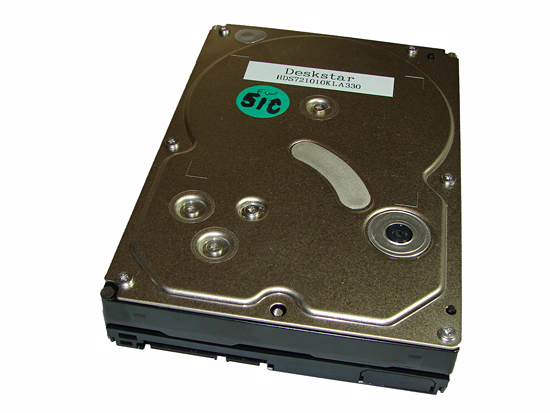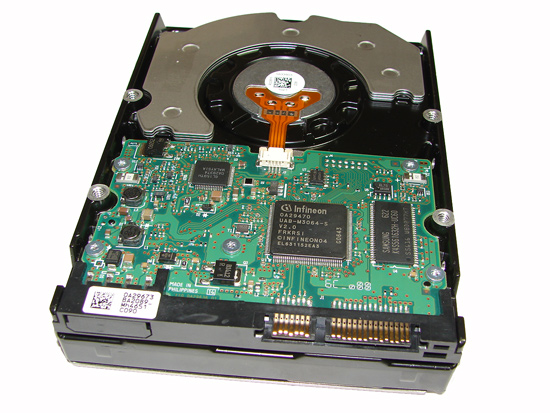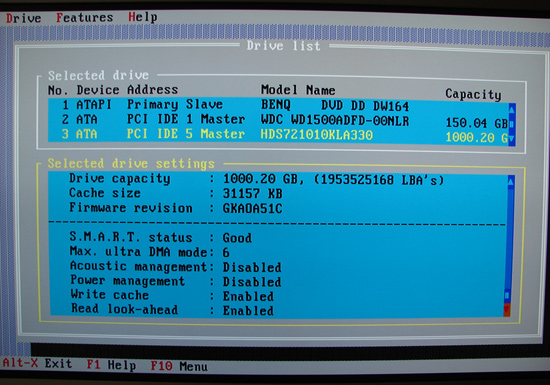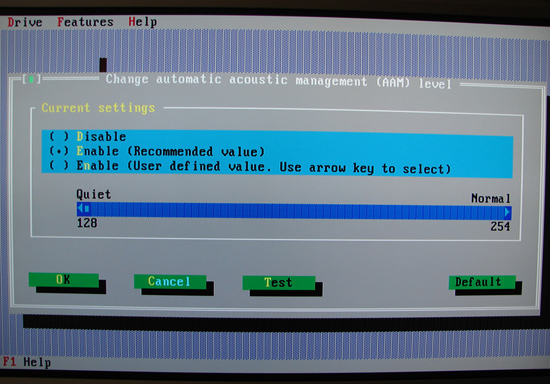Hitachi Deskstar 7K1000: Terabyte Storage arrives on the Desktop
by Gary Key on March 19, 2007 8:00 AM EST- Posted in
- Storage
Feature Set: Hitachi 7K1000

The external design of the Hitachi 7K1000 is the same as the majority of the TK or K series drives. The drive is based on the industry standard 3.5" form factor platform and would normally have the pertinent part number and warranty information embossed on a white sticker on the top of the casing. However, our O.E.M. sample was graciously provided by Dell and does not include this information. The only other differences between the O.E.M. and retail units will be the inclusion of an accessory kit, HD Feature Tool software (that can be downloaded separately), and the obligatory retail packaging.

The Deskstar 7K1000 ships with the Serial ATA data and power connector along with a space for a 4-pin Molex power connector designed for use with older ATX power supplies. Our early press photos included the 4-pin Molex connector but it appears the inclusion of it will be at the discretion of the O.E.M. or distribution locality. The 32MB of cache memory and controller logic is located on the outer side of the PCB.


Hitachi offers their excellent DOS based HD Feature Tool that allows the user to view the specifics of the drive and change certain options such as S.M.A.R.T., AAM, Power Management, and read and write optimizations. Our drive arrived with Automatic Acoustic Management turned on and set to the quietest level. We were able to easily set different levels or turn off AAM altogether. We found in our limited acoustical testing there was not a real difference between the 128 and 256 setting. Performance was slightly affected with AAM implemented but we felt the benefits of having it turned on outweighed any performance impact.
Hard Disk Test Comparison and Features
The Hitachi Deskstar 7K1000 is the first 1TB drive to ship based upon manufacturer's specifications with a 750 GB offering scheduled for availability next quarter. Of course the actual capacity of the drive is 931.5 GB, but due to the way manufacturers report capacity the drive is considered to be a 1TB offering. This drive is also Hitachi's first 3.5-inch hard drive to use PMR technology. Additional 1TB versions for the Enterprise and DVR/Set-Top markets will be released later this year.
The 7K1000 features a 5-platter 10-head perpendicular magnetic recording design with rotational speeds at 7200rpm. The cache size has been increased to 32MB from the previous 16MB on the TK series. Hitachi includes their ramp load/unload, advanced low-power idle modes, and thermal-fly height control technologies. This drive series also supports Native Command Queuing and hot-swap capabilities. The Hitachi Deskstar 7K1000 drives ship with a three year warranty and additional specifications can be found here.
The Hitachi 7K1000 drive we are reviewing today will be compared directly against the Seagate ST3750640AS 750GB and WD WD1500AHFD 150GB drives in our limited benchmark test suite. We have also included the results of drives from our previous articles and will provide additional results of the 7K1000 in our upcoming 500GB roundup.

The external design of the Hitachi 7K1000 is the same as the majority of the TK or K series drives. The drive is based on the industry standard 3.5" form factor platform and would normally have the pertinent part number and warranty information embossed on a white sticker on the top of the casing. However, our O.E.M. sample was graciously provided by Dell and does not include this information. The only other differences between the O.E.M. and retail units will be the inclusion of an accessory kit, HD Feature Tool software (that can be downloaded separately), and the obligatory retail packaging.

The Deskstar 7K1000 ships with the Serial ATA data and power connector along with a space for a 4-pin Molex power connector designed for use with older ATX power supplies. Our early press photos included the 4-pin Molex connector but it appears the inclusion of it will be at the discretion of the O.E.M. or distribution locality. The 32MB of cache memory and controller logic is located on the outer side of the PCB.


Hitachi offers their excellent DOS based HD Feature Tool that allows the user to view the specifics of the drive and change certain options such as S.M.A.R.T., AAM, Power Management, and read and write optimizations. Our drive arrived with Automatic Acoustic Management turned on and set to the quietest level. We were able to easily set different levels or turn off AAM altogether. We found in our limited acoustical testing there was not a real difference between the 128 and 256 setting. Performance was slightly affected with AAM implemented but we felt the benefits of having it turned on outweighed any performance impact.
Hard Disk Test Comparison and Features
| Hard Drive Specifications | |||
| Hitachi Deskstar 7K1000 1000GB HDS721010KLA330 | Seagate Barracuda 7200.10 750GB ST3750640AS | Western Digital Raptor 150GB WD1500ADFD | |
| Manufacturer's Stated Capacity: | 1000.2GB (1 Terabyte) | 750GB | 150GB |
| Operating System Stated Capacity: | 931.5 GB | 698.6 GB | 139.73 GB |
| Interface: | SATA 3Gb/s | SATA 3Gb/s | SATA 1.5Gb/s |
| Rotational Speed: | 7,200 RPM | 7,200 RPM | 10,000 RPM |
| Cache Size: | 32 MB | 16 MB | 16 MB |
| Average Latency: | 4.17 ms (nominal) | 4.16 ms (nominal) | 2.99 ms (nominal) |
| Read Seek Time: | 8.5 ms / 14ms Silent | 11 ms | 4.6 ms |
| Number of Heads: | 10 | 8 | 4 |
| Number of Platters: | 5 | 4 | 2 |
| Power Draw Idle / Load: | 8.1W / 12.8W | 9.3W / 12.6W | 9.19W / 10.02W |
| Power Draw Silent I / L: | 4.3W / 9.9W | - | - |
| Command Queuing: | Native Command Queuing | Native Command Queuing | Native Command Queuing |
| Warranty: | 3 Year - Retail or OEM | 5 Year - Retail or OEM | 5 Year - Retail or OEM |
The Hitachi Deskstar 7K1000 is the first 1TB drive to ship based upon manufacturer's specifications with a 750 GB offering scheduled for availability next quarter. Of course the actual capacity of the drive is 931.5 GB, but due to the way manufacturers report capacity the drive is considered to be a 1TB offering. This drive is also Hitachi's first 3.5-inch hard drive to use PMR technology. Additional 1TB versions for the Enterprise and DVR/Set-Top markets will be released later this year.
The 7K1000 features a 5-platter 10-head perpendicular magnetic recording design with rotational speeds at 7200rpm. The cache size has been increased to 32MB from the previous 16MB on the TK series. Hitachi includes their ramp load/unload, advanced low-power idle modes, and thermal-fly height control technologies. This drive series also supports Native Command Queuing and hot-swap capabilities. The Hitachi Deskstar 7K1000 drives ship with a three year warranty and additional specifications can be found here.
The Hitachi 7K1000 drive we are reviewing today will be compared directly against the Seagate ST3750640AS 750GB and WD WD1500AHFD 150GB drives in our limited benchmark test suite. We have also included the results of drives from our previous articles and will provide additional results of the 7K1000 in our upcoming 500GB roundup.










74 Comments
View All Comments
goldfish2 - Tuesday, March 20, 2007 - link
just noticed a problem you may wish to address with your charts, hope this hasn't already been mentioned.Take a look at the chart 'video application timing - time to transcode DVD'
Your times are in Minutes/seconds, it seems you're chart application has interpreted the numbers as decimals, and made the bar lengths on this basis. Take a look at the bar for WD5000YS 500GB. It says 4.59; I assume this means 4 minutes 59 seconds, making the WD740GD 2 seconds slower at 5 minutes 1 second. But the bar lengths are scaled for decimal, so that the bar on the WD740GD is much longer. You'll have to see if you can get your graph package to think in minutes:seconds, or have the bar lengths entered in decimal (i.e. 4:30 seconds becomes 4.5 minutes) and put a label on in minutes for readability.
Thanks for the review though.
Gary Key - Tuesday, March 20, 2007 - link
We have a short blurb under the Application Performance section -"Our application benchmarks are designed to show application performance results with times being reported in minutes / seconds or seconds only, with lower scores being better. Our graph engine does not allow for a time format such a 1:05 (one minute, five seconds) so this time value will be represented as 1.05."
We know this is an issue and hopefully we can address it in our next engine update (coming soon from what I understand). I had used percentage values in a previous article that was also confusing to some degree. Thanks for the comments and they have been passed on to our web team. ;)
PrinceGaz - Tuesday, March 20, 2007 - link
The simplest and most logical solution is just to enter the time in seconds, rather than minutes and seconds; even if graphed correctly, comparing values composed of two units (minutes:seconds) is difficult compared to a single unit (seconds).If two results were 6:47 and 7:04 for instance, the difference betweem them is much clearer if you say 407 and 424 seconds. By giving the value in seconds only, you can see at a glance that there is a 17 second difference, which translates to just over 4% (17 divided by 407/100, or 17 divided by about 4.1).
Doing the same mental calculation with 6:47 and 7:04 first involves working out the difference with the extra step of dealing with 60 seconds to a minute. Then you have a difference of 17 seconds out of a little under 7 minutes, which isn't very helpful until you convert the 7 minutes to seconds, as it should have been originally.
That's my opinion anyway.
JarredWalton - Tuesday, March 20, 2007 - link
Hi Gary. I told you so! Damned if you do, damned if you don't. ;) (The rest of you can just ignore me.)PrinceGaz - Tuesday, March 20, 2007 - link
How can you say only two years?
The 14 years you say it took to increase from 1GB to 500GB represents a doubling of capacity nine times, or roughly 1.56 years (19 months) for the capacity to double. That means that the two years (actually 20 months as Hitachi released a 500GB drive in Jul 2005) it took to double again, from 500GB to 1TB is actually marginally longer than average.
It would be more accurate to say that the trend of capacities doubling roughly every 18 months is continuing.
patentman - Tuesday, March 20, 2007 - link
The two year remark is two years from the first commercial perpendicular recording drive. Perpendicular recording has been in the works for a long time. In fact, when I used to examine patent applications for a living, there was patent literature related to perpendicular recording all the way back in 1990-1991, albeit for relatively simple aspects of the device.Gary Key - Tuesday, March 20, 2007 - link
The averaging of the time periods does work out to a doubling of capacities every 18~20 months but the last doubling took about 26 months to go from 250GB to 500GB.
mino - Wednesday, March 21, 2007 - link
Yes, but first 250GB drives were 4-platter 5400rpm ones(Maxtor?)...First 500GB were 5-platter 7200rpm ones.
IMO there are little dicrepancies in the tren dcaused bu the worry of many-platter drives after 75GXP. Aftre a few years Hitachi came back with 7K400 and the curve just returned to values it lost before...
scott967 - Tuesday, March 20, 2007 - link
On these big drives is NTFS performance an issue at all?scott s.
.
AbRASiON - Monday, March 19, 2007 - link
Too slow, too much money, too little space.I've owned 3 and sold them.
When are we going to see a 15krpm Savvio 2.5" review?
When will we see a 180gb per platter 32mb 10,000rpm new series raptor?
Maybe WD should also make a 15krpm 2.5" - 32mb model
These incrimental speed upgrades on hard disks are terrible :( need more, much much more.